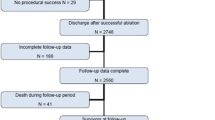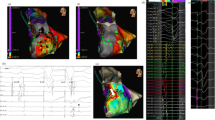Abstract
Background
Ventricular arrhythmia inducibility is one of the ideal endpoints of ventricular tachycardia (VT) ablation. However, it may be challenging to implement programmed electrical stimulation (PES) at the end of the procedure under several circumstances. The long-term outcome of patients who did not undergo PES after VT ablation remains largely unknown.
Purpose
To investigate the details and long-term outcome of VT ablation in patients who did not undergo PES at the end of the ablation procedure.
Methods
Among 183 VT ablation procedures in patients with structural heart disease who underwent VT ablation using an irrigated catheter, we enrolled those who did not undergo PES after VT ablation. VT ablation strategy involved targeting clinical VT plus pacemap-guided substrate ablation if inducible. When VT was not inducible, substrate-based ablation was performed. The primary endpoint was VT recurrence.
Results
In 58 procedures, post-ablation VT inducibility was not assessed. The causes were non-inducibility of sustained VT before ablation (27/58, 46.6%), long procedure time (27.6%, mean 392 min), complications (10.3%), intolerant hemodynamic state (10.3%), and inaccessible or unsafe target (6.9%). With regard to the primary endpoint, 23 recurrences (39.7%) were observed during a mean follow-up period of 2.5 years. Patients with non-inducibility before ablation showed less VT recurrences (4/27, 14.8%) during follow-up than patients with other causes of untested PES after ablation (19/31, 61.2%) (Log-rank < 0.001).
Conclusions
VT recurrence was not observed in approximately 60% of the patients who did not undergo PES at the end of the ablation procedure. PES after VT ablation may be not needed among patients with pre-ablation non-inducibility.

Similar content being viewed by others
References
Kuck K-HH, Schaumann A, Eckardt L, et al. Catheter ablation of stable ventricular tachycardia before defibrillator implantation in patients with coronary heart disease (VTACH): a multicentre randomised controlled trial. Lancet. 2010;375(9708):31–40. https://doi.org/10.1016/S0140-6736(09)61755-4.
Reddy VY, Reynolds MR, Neuzil P, et al. Prophylactic catheter ablation for the prevention of defibrillator therapy. N Engl J Med. 2007;357(26):2657–65. https://doi.org/10.1056/NEJMp1002530.
Jaïs P, Maury P, Khairy P, et al. Elimination of local abnormal ventricular activities : a new end point for substrate modification in patients with scar-related ventricular tachycardia. Circulation. 2012;125(18):2184–96. https://doi.org/10.1161/CIRCULATIONAHA.111.043216.
Briceño DF, Romero J, Villablanca PA, et al. Long-term outcomes of different ablation strategies for ventricular tachycardia in patients with structural heart disease: systematic review and meta-analysis. EP Eur. 2017:1–12. https://doi.org/10.1093/europace/eux109.
Di Biase L, Santangeli P, Burkhardt DJ, et al. Endo-epicardial homogenization of the scar versus limited substrate ablation for the treatment of electrical storms in patients with ischemic cardiomyopathy. J Am Coll Cardiol. 2012;60(2):132–41. https://doi.org/10.1016/j.jacc.2012.03.044.
Aziz Z, Tung R. Novel map** strategies for ventricular tachycardia ablation. Curr Treat Options Cardiovasc Med. 2018;20(4). https://doi.org/10.1007/s11936-018-0615-1.
Marchlinski FE, Callans DJ, Gottlieb CD, Zado ES. Linear ablation lesions for control of unmappable ventricular tachycardia in patients with ischemic and nonischemic cardiomyopathy. Circulation. 2000;101:1288–96.
Berruezo A, Fernández-Armenta J, Andreu D, et al. Scar dechanneling. Circ Arrhythmia Electrophysiol. 2015;8(2):326–36. https://doi.org/10.1161/CIRCEP.114.002386.
Tzou WS, Frankel DS, Hegeman T, et al. Core isolation of critical arrhythmia elements for treatment of multiple scar-based ventricular tachycardias. Circ Arrhythmia Electrophysiol. 2015;8(2):353–61. https://doi.org/10.1161/CIRCEP.114.002310.
Cronin EM, Bogun FM, Maury P, et al. 2019 HRS/EHRA/APHRS/LAHRS expert consensus statement on catheter ablation of ventricular arrhythmias. Vol 35. Wiley-Blackwell; 2019:323–484. http://www.ncbi.nlm.nih.gov/pubmed/31293696. Accessed June 6, 2019.
Hu J, Zeng S, Zhou Q, et al. Can ventricular tachycardia non-inducibility after ablation predict reduced ventricular tachycardia recurrence and mortality in patients with non-ischemic cardiomyopathy? A meta-analysis of twenty-four observational studies. Int J Cardiol. 2016;222:689–95. https://doi.org/10.1016/j.ijcard.2016.07.200.
Essebag V, Joza J, Nery PB, et al. Prognostic value of noninducibility on outcomes of ventricular tachycardia ablation: a VANISH substudy. JACC Clin Electrophysiol. 2018;4(7):911–9. https://doi.org/10.1016/j.jacep.2018.03.013.
Sauer WH, Zado E, Gerstenfeld EP, Marchlinski FE, Callans DJ. Incidence and predictors of mortality following ablation of ventricular tachycardia in patients with an implantable cardioverter-defibrillator. Hear Rhythm. 2010;7(1):9–14. https://doi.org/10.1016/j.hrthm.2009.09.014.
Ghanbari H, Baser K, Yokokawa M, et al. Noninducibility in postinfarction ventricular tachycardia as an end point for ventricular tachycardia ablation and its effects on outcomes a meta-analysis. Circ Arrhythmia Electrophysiol. 2014;7(4):677–83. https://doi.org/10.1161/CIRCEP.113.001404.
Carbucicchio C, Santamaria M, Trevisi N, et al. Catheter ablation for the treatment of electrical storm in patients with implantable cardioverter-defibrillators : short-and long-term outcomes in a prospective single-center study. Circulation. 2008;117(4):462–9. https://doi.org/10.1161/CIRCULATIONAHA.106.686534.
Hayashi T, Fukamizu S, Hojo R, et al. Prophylactic catheter ablation for induced monomorphic ventricular tachycardia in patients with implantable cardioverter defibrillators as primary prevention. EP Eur. 2013;15(10):1507–15. https://doi.org/10.1093/europace/eut050.
Soejima K, Stevenson WG, Sapp JL, Selwyn AP, Couper G, Epstein LM. Endocardial and epicardial radiofrequency ablation of ventricular tachycardia associated with dilated cardiomyopathy: the importance of low-voltage scars. J Am Coll Cardiol. 2004;43(10):1834–42. https://doi.org/10.1016/j.jacc.2004.01.029.
Soejima K, Stevenson WG, Maisel WH, Sapp JL, Epstein LM. Electrically unexcitable scar map** based on pacing threshold for identification of the reentry circuit isthmus: feasibility for guiding ventricular tachycardia ablation. Circulation. 2002;106(13):1678–83. https://doi.org/10.1161/01.CIR.0000030187.39852.A7.
Santangeli P, Marchlinski FE. Substrate map** for unstable ventricular tachycardia. Hear Rhythm. 2016;13(2):569–83. https://doi.org/10.1016/j.hrthm.2015.09.023.
Callans DJ. Can we eliminate noninducibility by programmed stimulation as an endpoint for ventricular tachycardia ablation in patients with structural heart disease? J Cardiovasc Electrophysiol. 2012;23(6):628–30. https://doi.org/10.1111/j.1540-8167.2011.02274.x.
Stevenson WG, Wilber DJ, Natale A, et al. Irrigated radiofrequency catheter ablation guided by electroanatomic map** for recurrent ventricular tachycardia after myocardial infarction: the multicenter thermocool ventricular tachycardia ablation trial. Circulation. 2008;118(25):2773–82. https://doi.org/10.1161/CIRCULATIONAHA.108.788604.
Arenal A, Glez-Torrecilla E, Ortiz M, et al. Ablation of electrograms with an isolated, delayed component as treatment of unmappable monomorphic ventricular tachycardias in patients with structural heart disease. J Am Coll Cardiol. 2003;41(1):81–92. https://doi.org/10.1016/S0735-1097(02)02623-2.
Yokokawa M, Kim HM, Baser K, et al. Predictive value of programmed ventricular stimulation after catheter ablation of post-infarction ventricular tachycardia. J Am Coll Cardiol. 2015;65(18):1954–9. https://doi.org/10.1016/j.jacc.2015.02.058.
Author information
Authors and Affiliations
Corresponding author
Ethics declarations
Conflict of interest
The authors declare no competing interests.
Additional information
Publisher's note
Springer Nature remains neutral with regard to jurisdictional claims in published maps and institutional affiliations.
Supplementary information
Below is the link to the electronic supplementary material.
Rights and permissions
About this article
Cite this article
Kitamura, T., Fukamizu, S., Arai, T. et al. Long-term outcome of ventricular tachycardia ablation in patients who did not undergo programmed electrical stimulation after ablation. J Interv Card Electrophysiol 66, 215–220 (2023). https://doi.org/10.1007/s10840-021-01037-4
Received:
Accepted:
Published:
Issue Date:
DOI: https://doi.org/10.1007/s10840-021-01037-4




